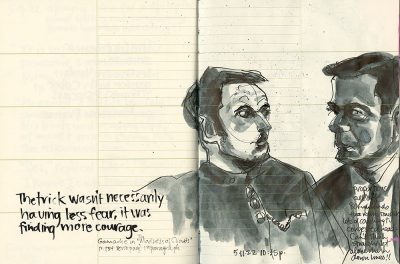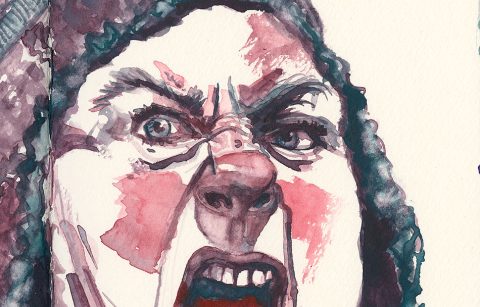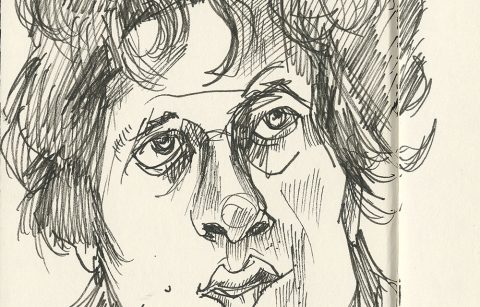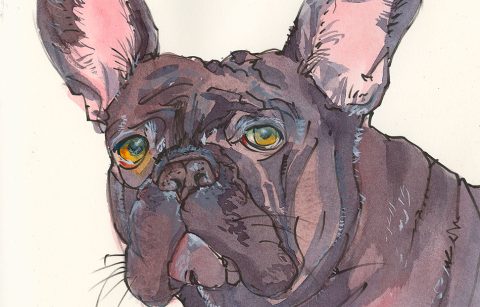 There are a lot of ways to work out what needs to go down on your journal page. The most obvious way is to think about the overall design and layout of the page or page spread.
There are a lot of ways to work out what needs to go down on your journal page. The most obvious way is to think about the overall design and layout of the page or page spread.
I see a lot of visual journaling students tie themselves in knots as they compose a page—thinking where everything needs to go and what to do with any resultant white space. This week I have some “In Context” page spreads to show you that the world doesn’t end if you let go of over-thinking and let things happen.
Here we have a messy sketch, quickly done at the end of the day. I was watching “Murdoch Mysteries” on TV and didn’t want to stay up to create a “finished” drawing. I just wanted to capture something in the pose of the two actors. (Setting my intention.)
Because I set my intention appropriate to the time available I can actually look fondly at this rough sketch. I can see all the light shifts I was seeing, the main shapes on the face, and even, somewhere in all of this, more likeness than I was hoping for.
But what I love about this page spread in my journal is that earlier in the day I was reading and wrote down a quotation (verso page). And then later when I saw something in “MM” that I wanted to sketch I didn’t dither around and think about what I should save this page for or what I could sketch that would go with the quotation. I just picked up the took and thought, “I can sketch this observation in this space.” So I did.
This approach works whether you are at home with the TV, facing a studio still life set up, or out and about at the zoo. Just get something down on the journal page.
Of course think about layout and design. Students from my design course know I have hours and hours of stuff to say about that! I’ll deal with that in other posts as I have in the past.
Today I just want to encourage you to get something down on the page. Set an intention, understand your expectations and recalibrate them if necessary, and then just go for it.
When you do this, something wonderful usually happens, the things you gather in your day actually go together—Serendipity!
That’s because in the acts of observation and reflection you’ve set your mind’s antenna to seek out and notice similar things. It happens effortlessly. In fact it’s something that is so consistent that you can recalibrate a bad mood by starting the day with some gratitude and observations about something beautiful (like, oh, I’d say a sleeping dog) and see where it brings you the rest of the day.
Keep this in mind as you work on your journal pages. It’s great to think about composition and negative space, contrast, borders, edges, working through the gutter, bleeding off the edge, invisible margins and columns, to name just a few things that run through the background in my head as reflexes after working so many decades in publishing.
Do think about those things to the level that they matter to you—but always keep moving through your day, being in the present moment and responding to what’s around you, and then seeing in retrospect how serendipity happens.
Keep making pages.























“always keep moving through your day, being in the present moment and responding to what’s around you” — I love this. I will keep trying to do it. Thank you so much for the reminder!
Tina, I’m glad you liked that. But I know you are doing exactly this when you’re doing your sketches. You keep on keeping on!
And how clever of you to put Louise Penny and Maureen Jennings together on the same page! Speaking of Louise Penny, have you read the book she co-wrote with Hilary Clinton? Quite a good story.
Christine, you made me smile. I didn’t even think about how these two authors were both Canadian until you made this comment. It’s not how I categorize them in my brain. I’d have to go down several levels of organization to hit this. I love it MORE SERENDIPITY!!!! Thank you.
I’ve heard Penny wrote a book with Clinton but I have not read it yet. That’s for reminding me to check it out. I’m glad it’s good. I wonder if I can read a book by Penny without Inspector G in it?!